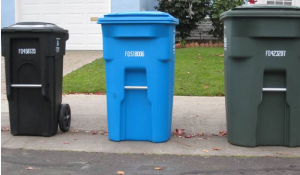
Many Palo Alto residents were aghast last week when the city decided to hike trash rates for the second time since last year. The city said consumers have done such a good job in recycling that they have less trash, so that now the city’s garbage fund is going broke.
Palo Alto has been using money from collecting garbage to pay for the recycling, which, for residents, is free.
It seems that Palo Alto is not the only city facing this financial dilemma. Most cities on the Peninsula encourage residents to conserve by using smaller trash containers, so they are also seeing their income drop drastically. Each is struggling to right the ship.
In January, San Mateo County hiked its garbage-collection rate by 14.7 percent in some unincorporated areas, including Burlingame Hills, San Mateo Highlands, Baywood Park and others.
Last December, Belmont approved a trash-rate hike of 11.6 percent for residents and businesses, and San Carlos now charges residents 5.3 percent more for garbage collection.
“What’s ironic is the better we do in recycling, the more unsustainable our rate structure is,” said Phil Bobel, Interim Assistant Director of Public Works for Palo Alto.
The refuse fund, which the city uses to pay for its trash collection, recycling, composting, and street sweeping services, has been losing money for several years. According to a city report, the fund has a budget deficit of $3.7 million for this fiscal year. The revenues shortfalls can, in many ways, be attributed to the city’s success in encouraging conservation through what it calls its “Zero Waste” program. By switching to smaller cans, residents bring down their trash bills and, in doing so, reduce the city’s revenues. In addition, more people are recycling, for which the city has not been charging its residents.
That, however, may soon change.
Bobel said the city expects to charge residents for a broad range of services, including garbage collection and disposal, yard-waste collection and processing and recycling collection and processing.
Palo Alto’s City Council began dealing with this issue last year when it added a flat rate of $4.62 to each residential bill, regardless of can size.
But on March 6, the council’s finance committee endorsed a proposal to add an additional $2.09 fee for street sweeping and additional fees to pay for the city’s hazardous waste collection and processing.
A recently completed “cost of service” study by the city proposes even more significant changes. Under a suggested model, Palo Alto would start charging residents $7.66 for recycling, and $10.99 for picking up their yard trimmings. Residents who use mini-cans would see their monthly refuse rates jump from $20.52 to $45.46, a 121 percent increase. Residents who use the standard 32-gallon cans would see their monthly rates go up from $37.58 to $50.48, a 37 percent increase.
However, on March 6 the committee and staff opted not to go that far but to pursue a series of small, incremental increases instead.
“We are suggesting phasing in.” Bobel said. “We would take baby steps.”
By increasing the rates, city officials said they are also trying to bring the refuse system into compliance with Proposition 218, a state law that bars cities from setting rates that exceed the cost of providing the services for which these rates are charged.
“Any changes we are making are really to address Proposition 218 and the results of our cost-of-service study,” Public Works manager Brad Eggleston said during the Finance Committee’s meeting.
However, some residents have been outspoken in opposition of the rate hikes.
“They just raised my rates a year ago or so, and now they are at it again,” wrote an anonymous a resident of the Crescent Park neighborhood, on the Palo Alto Online website March 7, “They are doing much less work, picking up much less trash, and demanding more money.”
The resident, who was joined by many other online commenters who were against the rate hikes, added. “How can that be?”
“The whole trash issue is never gonna end,” wrote Malcolm Fartze, a resident of the Fairmeadow neighborhood, on the same day. “It’s time for our politicians to do what is right and stop the act.”
Despite the high costs, the city’s waste-reduction efforts are expected to accelerate in the coming years.
The city’s goal, which the council adopted in 2004 and called “Zero Waste”, is to divert almost all waste from landfills by 2021. The city’s diversion rate right now is 80 percent, Bobel said.
But each step toward “Zero Waste” might bring a greater financial challenge. For ratepayers, this means that even if they reduce their trash loads, rates are still likely to go up.
Because the city can no longer not afford to completely subsidize recycling, Bobel said, it may have to look for other incentives to encourage residents to recycle and conserve. The city has also been trying to let residents know about the true costs of garbage collection, including the costs to the environment.
“The cost of going green is going up,” Foster City’s Mayor Art Kiesel said in November when the city council approved a 6.4 percent increase to garbage rate for 2012.
“People living in the area don’t recycle just because it’s a nice thing to do,” Bobel said. “We recognize that it’s part of the changing behavior, and we have to pay for the price of it.”
Whatever happens, the environment will likely benefit, even though the bottom line doesn’t. And for ratepayers in the area, this may soon be the only remaining solace.

Pingback: Must-Know News – 3/20/12 – S&P May Downgrade Almost All U.S. CDOs Backed by Structured Debt; Bad Loans At Spanish Banks Rise To 7.91% In January « Investment Watch Blog – 2012